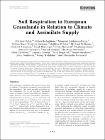| dc.identifier.citation | Bahn, M., Anderson, M., Dore, S., Gimeno, C., Drosler, M., Williams, M., Acosta, M., Ammann, C., Berninger, F., Flechard, C., Jones, S., Kumar, S., Newesely, R.S., Pavelka, M., Priwitzer, T., Raschi, A., Siegwolf, R., Susiluto, S., Tenhunen, J., Wohlfahrt, G., and Cernusca, A.,, Soil respiration in European grasslands in relation to climate and assimilate supply, ECOSYSTEMS, 11, 2008, 1352 - 1367 | en |
| dc.description.abstract | Soil respiration constitutes the second largest flux of carbon (C) between terrestrial ecosystems and the atmosphere. This study provides a synthesis of soil respiration (Rs) in 20 European grasslands across a climatic transect, including ten meadows, eight pastures and two unmanaged grasslands. Maximum rates of Rs (Rsmax), Rs at a reference soil temperature (10?C; Rs10) and annual Rs (estimated for 13 sites) ranged from 1.9 to 15.9 ?mol CO2 m?2 s?1, 0.3 to 5.5 ?mol CO2 m?2 s?1 and 58 to 1988 g C m?2 y?1, respectively. Values obtained for Central European mountain meadows are amongst the highest so far reported for any type of ecosystem. Across all sites Rsmax was closely related to Rs10.
Assimilate supply affected Rs at timescales from daily (but not necessarily diurnal) to annual. Reductions of assimilate supply by removal of aboveground biomass through grazing and cutting resulted in a rapid and a significant decrease of Rs. Temperature-independent seasonal fluctuations of Rs of an intensively managed pasture were closely related to changes in leaf area index (LAI). Across sites Rs10 increased with mean annual soil temperature (MAT), LAI and gross primary productivity (GPP), indicating that assimilate supply overrides potential acclimation to prevailing temperatures. Also annual Rs was closely related to LAI and GPP. Because the latter two parameters were coupled to MAT, temperature was a suitable surrogate for deriving estimates of annual Rs across the grasslands studied. These findings contribute to our understanding of regional patterns of soil C fluxes and highlight the importance of assimilate supply for soil CO2 emissions at various timescales. | en |
| dc.description.sponsorship | The study was funded by the EU FP5 projects
CarboMont (EVK-2001-00125) and GreenGrass
(EVK-2001-00105); data analysis was supported by
the Austrian National Science Fund (FWF) project
P18756-B16. We acknowledge assistance in data
collection by Nadine Pfahringer, Anton Pallua,
Anton Stefan Schwarz, Robert Bajo, Christian
Skublics, Yuelin Li and Silvia Baronti. | en |




